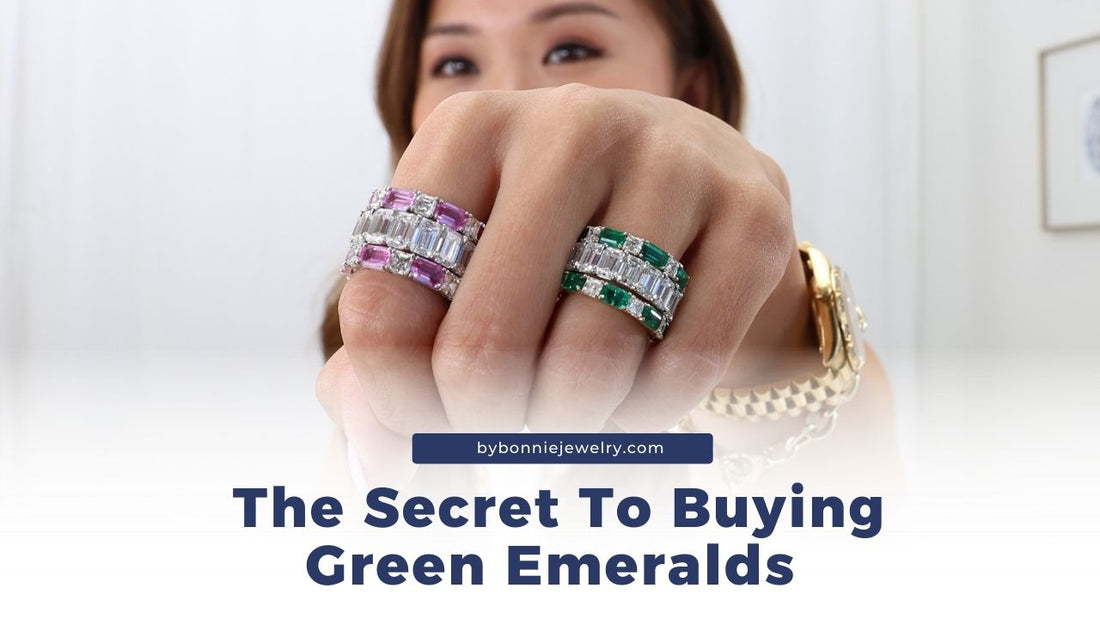
How To Buy a Green Emerald Band
Share
Every time I finish a project this magnificent, I have to take a deep breath. Hi, loves—it’s Bonnie with By Bonnie Jewelry, where we talk about all things diamonds, craftsmanship… and now, stunning color gemstones, too.
If you’ve been dreaming about green emeralds—or just love vibrant colors—but have no idea where to start, this blog is your guide. When you search for “green emerald,” you’ll see everything from bargain prices to pieces worth millions. How do you know what’s right for you? Today, I’m pulling back the curtain and showing you the exact curation process I used for my client Laura. Hi, Laura!
I’ll walk you through what to look for, what to avoid, and how to set a smart price point.
Step One: Choosing the Right Color and Hue
When I look at a green emerald, the first thing I notice is color—and I check it in different lighting. I want to see vibrancy and life. For me, a rich, lush green is ideal, but some people prefer a lighter, fresher tone.
Emeralds can come from Zambia, Colombia, Russia, and each source offers a slightly different hue. The most important thing? Find a color that excites you.
Step Two: Avoid Emerald Stones That Look Dull
What I avoid: dull stones with a lifeless or grayish undertone. Emeralds should make you feel something at first glance.
And yes—natural inclusions are 100% acceptable in emeralds. Fun fact: emeralds belong to the beryl family, along with aquamarine and morganite.
These gemstones are a bit softer and more brittle, which is why many emeralds are treated with natural oil to enhance clarity—a completely accepted practice in the jewelry trade.
Step Three: Green Emerald Prices
Green emerald prices can range from a few hundred dollars to millions. The key is to balance color, beauty, and your personal budget.
For me, the magic happens when a stone’s color speaks to my heart and fits within the price point I’ve set.
Step Four: My Behind-the-Scenes Curation Process
Color gemstones are trickier than diamonds because their calibration is different. Here’s what I focus on:
-
Uniformity in color
-
Saturation
-
Clarity
For this project, we wanted something inspired by one of my own rings. My client wanted to invest in her collection and decided on larger stones for impact. We kept the design versatile so it could be stacked with her existing pieces.
Precision in the Details
Every stone in this band was precisely calibrated to 3.27mm. That’s the level of detail we work with—because when you’re stacking with diamonds or other bands, alignment is everything.
Compared to a pink sapphire band we’d done earlier, this emerald version is chunkier, but still uses Asscher cuts. I love that square shape because it lets the green sit closer together, making the color pop even more.
Craftsmanship & Uniqueness
Custom bands like this require engineering, careful matching, and old-world craftsmanship. No two sets will ever be identical—natural gemstones vary in color and inclusions, which is part of their charm.
I’ve also worked with lab-grown emeralds, which tend to have a more uniform color. Some people love that perfect consistency; others prefer the organic variety of natural stones.
Bonus: Caring for Your Green Emeralds
-
Avoid harsh chemicals and ultrasonic cleaners—many emeralds are oil-treated, and you could damage them.
-
Remove before activities like gardening, cooking, or working out—emeralds are softer and can chip.
If you adored this emerald feature, follow me on Instagram @bybonniejewelry for more behind-the-scenes looks. And if these bands are calling your name, you’ll find them linked on my website.
What color gemstone should we explore next—blue sapphire or ruby?

